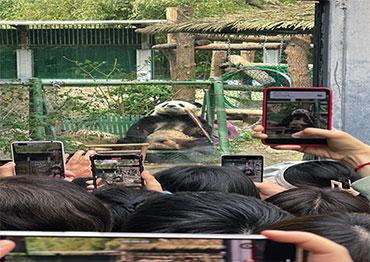Dong Qiwen, a history professor at Fudan University in Shanghai, has closely observed panda fan communities since 2017. He said that fans are increasingly taking their influence offline, and it is having negative effects.
“Essentially speaking, as the giant pandas they love are real, the love and care of these fans overflows from cyber space to social spaces. The relationships between fans and giant panda institutes and zoos is becoming strained,” Dong said.
Dong observed that many fans have developed their general fondness and interest into something deeply emotional. Some form a virtual “parent-child” relationship with their particular panda.
“When fans start to treat pandas as their virtual sons and daughters, they view zoos and conservation institutes very much like schools. If a school is suspected of violating students’ rights, parents will certainly complain and protest. ‘Panda moms,’ in a similar way, would accuse the zoo of abusing giant pandas if they believe the zoo has shown some signs of negligence or mistreatment,” Dong told NewsChina.
This scrutiny extends to panda keepers. Known as nai bama (nanny dads and moms) in fan communities, those who interact with fans more are usually deemed caring and responsible, while those less so are labeled as cold and indifferent – even potential abusers.
Some keepers become victims of bullying both on and offline. Many giant panda institutes require that keepers never respond, no matter how severe the verbal attacks are.
In April, a video showing a keeper at Nanjing Ziqinghu Wildlife Park prodding panda Nuan Nuan with a bamboo pole to hurry her to her shelter went viral on social media. Fans lambasted both the keeper and park, slinging accusations of animal abuse. The keeper was subjected to cyber violence. On April 17, the park made a public apology, saying the keeper was no longer allowed to work with its pandas.
After having watched the video, a zoo manager who spoke with NewsChina on condition of anonymity said the keeper had done nothing wrong and the punishment he suffered, meted out under the pressure of public opinion, was unfair.
“Almost all giant panda institutes in China face verbal attacks from fans of varying degrees,” the manager said.
Conflict intensifies when fans discover that institutes had failed to notice a panda’s health issue in time or when they suspect it is not receiving proper treatment.
Two years on, a fiasco surrounding giant panda Ya Ya has still not abated. Sent to the US in 2003 with her male companion Le Le, the 22-year-old panda spent two decades at Memphis Zoo in Tennessee. In 2021, Ya Ya appeared thin with patches of pinkish, raw skin. Netizens accused the zoo of abuse. In a released statement, the zoo said Ya Ya has a chronic skin and fur condition, which “occasionally made her fur look thin and patchy.”
In February, Le Le died of heart disease at 25, further fueling anger among giant panda fans in China. The life span of giant pandas is 14-20 years in the wild and up to 30 in captivity, according to the WWF.
On April 27, Ya Ya bid farewell to the US for China after the end of the 20-year loan agreement. Now some Chinese are calling for the return of three-year old panda cub Xiao Qi Ji and his parents, Mei Xiang and Tian Tian, from the Smithsonian’s National Zoo in Washington, DC, accusing the zoo of mistreatment.
In contrast, when Samsung-sponsored Panda World in South Korea announced it would be returning three-year-old cub Fu Bao to China, many Chinese fans called for the contract’s renewal, saying the keepers have made Fu Bao “the happiest panda in the world.” Meng Lan’s “nanny dads” are also praised for their “loving hearts.”
What troubles Liu Ling most is the infighting between fan clubs. Supporters quarrel over trivialities – comparing their favorites in everything from appearance and cuteness to online popularity and what foods they eat.
“Fans nowadays are increasingly hot tempered. The online communities are like powder kegs – a little spark could set them off at any moment,” Liu said.
“Some more extreme fans believe their cubs should get the most bamboo shoots, have the most toys and receive the best care. They think their cubs should eat food at a fixed time. If their [favorite] panda ate apples at 9am yesterday but not today, they take it as a sign of mistreatment,” the anonymous zoo manager said.
“But in order to equip pandas with better survival skills for the wild, the amount and types of food and feeding times can’t be fixed. Otherwise, pandas can easily develop rigid habits. But many fans don’t believe this. They think these are excuses,” the zoo manager said.
Dong Qiwen said panda institutes and professionals, which had focused solely on science and research in the past, are largely unequipped to deal with a potentially volatile public. “Nowadays, what troubles institutes most is the problem of people – humans are always much more difficult to deal with than pandas. Coping with the problem of extreme fans has become a tough public relations issue that every giant panda institute faces,” Dong told NewsChina.

 Old Version
Old Version






